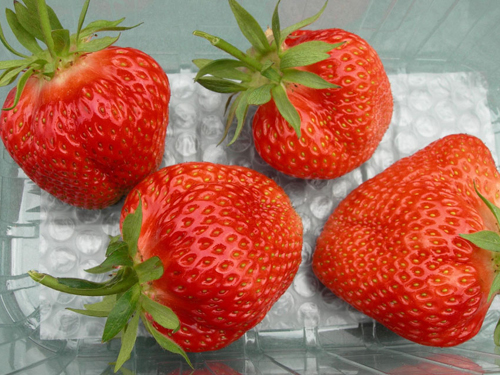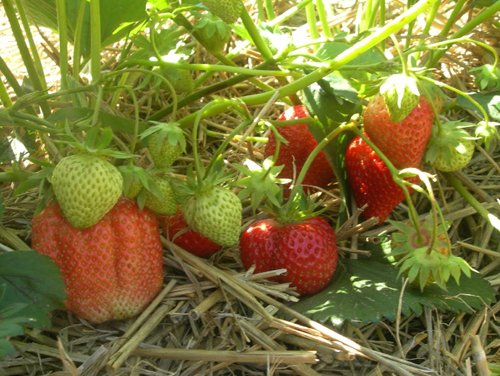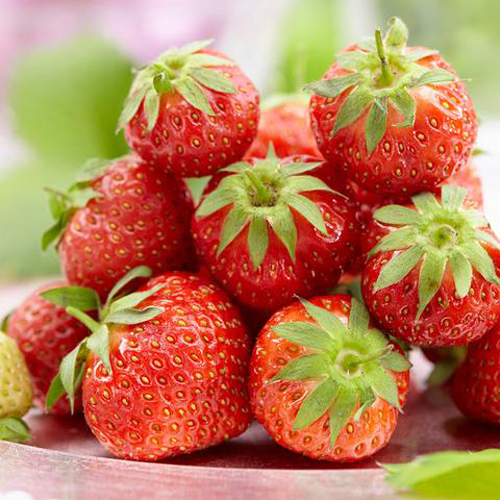Lambada strawberry variety
Lambada is an early-ripening non-repaired variety of garden strawberries (strawberries) for universal use. Bred in the Netherlands in 1982 by crossing hybrid forms IVT-74 112 (Primella x Karina) and IVT-76 013 (Holiday x Silvette). The following selection was carried out over the obtained plants, the largest-fruited specimens were selected. After fixing the varietal characteristics, the market was presented with the new Lambada, and very soon many farmers and gardeners fell in love with it. She has excellent taste, thanks to which gardeners often add her to the list of their favorites. Strawberries are suitable for growing both in open and closed ground, they feel great in various climatic conditions, they calmly react to thickening, thanks to which they can be grown using the technology of compacted plantings.

The plant is tall, vigorous, open type, erect, medium foliage. In general, the bushes look quite compact. The variety forms an abundant number of whiskers. The leaves are large, bright green. The flowers are large, bisexual, with well-developed stamens. Abundant flowering. Peduncles are powerful, strong, high, and are laid on the ground under the weight of the fruit.
The berries of Lambada are large, regular conical, sometimes slightly elongated, and are uniform. The skin is bright red, shiny. Achenes yellow, shallowly impressed, almost superficial. The pulp is moderately dense, light red in color, juicy, with a delicate texture and a pleasant, pronounced strawberry aroma. A characteristic feature of the variety is that the sepal is raised upward.
Strawberry tastes really great! The taste is truly strawberry, very sweet, but not cloying, has a tasting score of 5 points out of five. In terms of taste, our heroine surpasses many other varieties on the site, often becomes a favorite of gardeners. In addition, even not fully ripe berries are very sweet, often sweeter than fully ripe fruits of other varieties. Despite the rather modest yield, Lambada absolutely deserves a place on your site precisely because of its excellent taste.
Strawberries are versatile in use, perfect for any kind of processing and freezing, and, of course, are great fresh. They have an excellent presentation and uniformity - everything is as on selection, very beautiful and attractive. Thus, our heroine is very promising for growing in order to sell fresh products on the market. But in industrial production, it has not worked very well, therefore, it is quite attractive for cultivation on a small scale, but for production areas it is better to find another variety, more productive. In addition, the berries are not characterized by high transportability and excellent keeping quality, but they tolerate transportation over short distances calmly.

The average weight of strawberries in the season is 25-30 grams, Lambada has a very stable fruiting, the berries do not shrink by the end of the harvest. Moreover, there is a high percentage of large specimens and a large share of marketable fruits, there are very few substandard fruits. The yield of the variety is quite good, it is possible to collect about 700-900 grams of berries from a bush, sometimes up to 1 kg. Approximately 100-120 centners of fruit are obtained from a hectare of area. Such a potential really cannot be called high, but it is not small either, but it is precisely the yield indicators that do not allow our heroine to take a place among the favorites of the strawberry market. On the other hand, it is suitable for growing with compacted plantings, which will allow you to get a more bountiful harvest from a certain area, but in this case you will have to spend money on purchasing more seedlings, and to strengthen disease prevention measures, which can also cost a pretty penny.
Lambada ripens early, roughly on par with the variety Clery, a little bit later Albsearlier than Olbia. On average, the beginning of fruiting falls on May 10-15, it lasts about a month, ripening occurs in unison, so the harvest is fruitful and in a short time, which is very convenient. Another "bonus" is that the bushes are erect and very open, which makes it easier to visually detect the berries, as a result of which the harvest is faster and more pleasant. By the way, in the first year of life on the site, the plants may not please with the harvest, but you should not be disappointed - in the second year, strawberries will show what they are capable of. In general, many gardeners practice this technique - they do not allow the bushes to bear fruit in the first year after planting. But for our heroine this is not very relevant, it would be much better to simply provide her with abundant nutrition and good care, then in the first year you can get a wonderful harvest.
The variety is resistant to gray rot, verticillary wilt. Susceptible to powdery mildew, white and brown spots, may be affected by red root rot. In principle, gardeners do not particularly complain about the weak immunity of plants, they get sick no more often than other varieties on the site. Of course, timely, high-quality prevention is highly desirable, even necessary, especially if strawberries are grown in dense plantings. It is also extremely important to carry out mandatory sanitary cleaning of the plantation in spring and autumn, and to remove diseased specimens.

Lambada has good winter hardiness, but it can suffer in winters with little snow or very cold, so it is still advisable to provide plants with good shelter. Due to early flowering, covering materials are also relevant in the spring, especially in those regions where return frosts often rage in the spring. The drought tolerance of strawberries is also quite decent, in hot seasons it feels quite comfortable, however, the lack of moisture negatively affects the yield and health of the plants, so it is advisable to ensure planting with regular watering. But in rainy seasons, it is worth taking care of more enhanced protection of the plantation from fungal diseases.
The agricultural technology of the variety does not differ in any peculiarities, everything is pretty standard. Watering, fertilizing, weeding, soil loosening, preventive treatments. One of the main nuances is that you need to control the number of mustaches. Lambada is distinguished by abundant production, and if you do not follow this, then you can not count on a good harvest. On the other hand, this nuance can be a plus - there will be no problems with the reproduction of strawberries, and there will be many seedlings for sale, and the demand for this variety is quite high. Mineral complexes are preferred as top dressing, but with organic fertilizers you need to be careful, they are applied at the time of planting and before fruiting. Good nutrition has a very positive effect on the yield of plants and the taste of berries, so do not skimp on feeding.
Bushes are planted at a distance of 25-30 cm from each other, in the aisles the width should be about 30-35 cm.This very dense planting allows you to fit more plants in a small area, two Lambada bushes take up almost as much space as one bulk specimen of a late-ripening variety Malvina, for example, or early Kent... As for the longevity of strawberries, this issue is not much discussed by gardeners, so there is very little data. Therefore, it is advisable to say only that the planting should be updated as needed, depending on the intensity of use. Due to the stable, abundant fruiting, plants are not able to please you for more than 5 years, therefore, timely rejuvenation of the plantation is extremely necessary to avoid disappointment.
Let's summarize.Lambada is an excellent variety, especially attractive for cultivation on a personal plot for personal consumption. It has excellent taste, is quite undemanding to care for, and pleases with an early harvest. Among the commercial varieties, our heroine does not look particularly promising due to the average yield and insufficient transportability of berries. And in the opinion of some gardeners, even for a farmer, this strawberry is not particularly attractive, since the fruits are very poorly stored, and even during transportation, even over short distances, they often wrinkle and flow, losing their presentation. In a word, for the use of berries, as they say, from a bush, Lambada is simply magnificent, but for other purposes it is better to pay attention to other varieties.
A big disadvantage of the variety is its susceptibility to spotting, which is why it is necessary to pay more attention to preventive treatments. But the taste of our heroine more than covers this nuance. And in general, almost all popular commercial varieties need very high-quality disease prevention, so a small flaw in Lambada can be forgiven. It is very reliable and clearly will not let you down, so feel free to settle it on your site.








